Visiting Texas for business or pleasure? If so, the Museum of Fine Arts, Houston is hosting an exhibition worth its weight in gold. But visitors only have until February to glimpse Ancient Luxury and the Roman Silver Treasure from Berthouville.
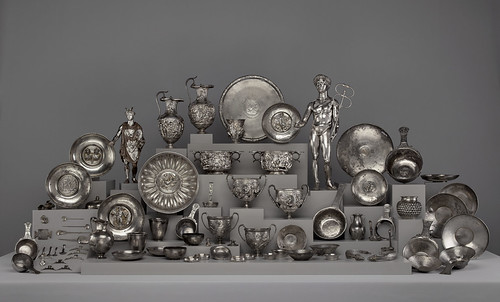
Roman, The Berthouville Treasure, silver and gold, Bibliothèque nationale de France, département des monnaies, médailles et antiques, Paris. © The J. Paul Getty Museum
In the spring of 1830, French farmer Prosper Taurin discovered the treasure trove while plowing a field near the village of Berthouville, Normandy. The priceless cache revealed 90 silver objects weighing 55 pounds and dating to the first and second centuries.
Shortly after Taurin found the monumental treasure, the Cabinet des Medailles of the Bibliotheque Nationale de France’s royal collection acquired the precious find. Now, the collection is known as the Berthouville Treasure.
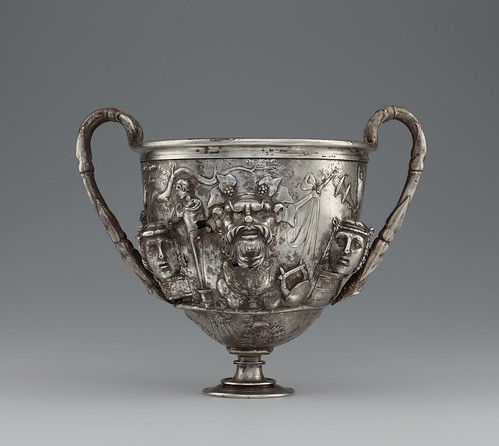
Roman, Cup with Masks (one of a pair), 1–100 AD, silver, Bibliothèque nationale de France, département des monnaies, médailles et antiques, Paris. © The J. Paul Getty Museum
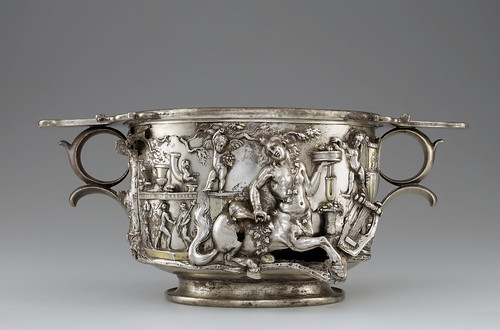
Roman, Cup with Centaurs (one of a pair), 1–100 AD, silver and gold, Bibliothèque nationale de France, département des monnaies, médailles et antiques, Paris. © The J. Paul Getty Museum
“These unique objects offer insight into the diverse role luxury arts played in ancient society,” said Frances Marzio, MFAH organizing curator of antiquities. She added that the opulent objects also reveal technology used by artisans in the ancient Roman Empire, as well as culture and religious aspects of life.
This is the exhibition’s final stop on a four-venue U.S. tour. Ancient Luxury and the Roman Silver Treasure from Berthouville closes Sunday, Feb. 5, at the MFAH and returns to France in the spring.
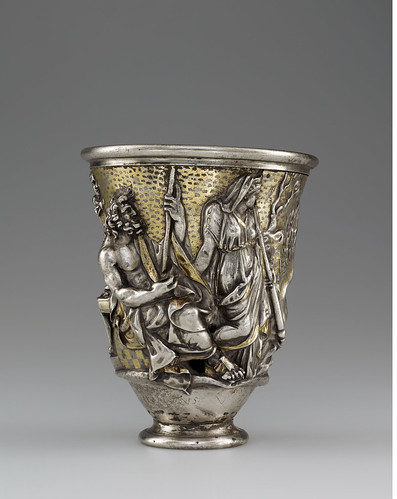
Roman, Beaker with Imagery Related to Isthmia and Corinth, 1–100 AD, silver and gold, Bibliothèque nationale de France, département des monnaies, médailles et antiques, Paris. © The J. Paul Getty Museum
Made up of more than 170 shimmering gold and silver objects, the exhibition includes outstanding artworks such as the “Patera of Rennes,” a libation bowl representing one of the few surviving examples of gold Roman tableware.

Roman, Offering Bowl with Bacchus, Hercules, and Coins, “Patera of Rennes,” c. 210 AD, gold, Bibliothèque nationale de France, département des monnaies, médailles et antiques, Paris. © The J. Paul Getty Museum
The Roman Emperor Marcus Ulpius Traianus was born in Italica, Spain in modern-day Andalucia. He ruled from 98 to 117 and died in Turkey. The benevolent emperor acquired the name “Trajan” early in life and is represented in an intricately carved bejeweled cameo made from multilayered sardonyx.
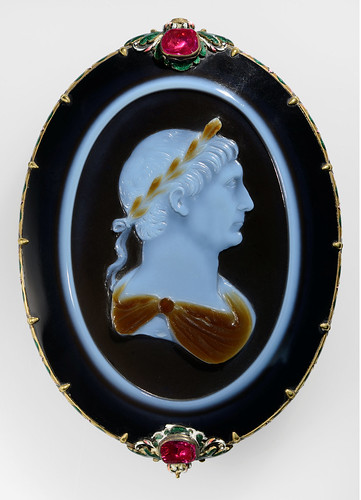
Roman, Cameo of Emperor Trajan, c. 100 AD, sardonyx set in a 17th-century gold, enamel, and ruby mount, Bibliothèque nationale de France, département des monnaies, médailles et antiques, Paris. © The J. Paul Getty Museum
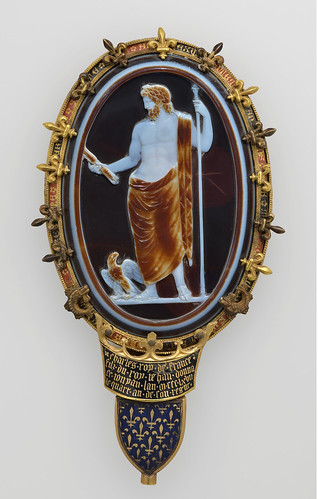
Roman, Cameo of Jupiter (The Cameo of Chartres), c. 50 AD, sardonyx set in a 14th-century gold and enamel mount, Bibliothèque nationale de France, département des monnaies, médailles et antiques, Paris. © The J. Paul Getty Museum
Another must-see example of art-infused luxury items is the “Shield of Scipio” plate of silver and gold. The extraordinary work of art depicts Homer’s legendary hero, Achilles. The plate was retrieved from the Rhone River in France in 1656.

Roman, Plate with the Embassy to Achilles (The Shield of Scipio), 375–400 AD, silver and gold, Bibliothèque nationale de France, département des monnaies, médailles et antiques, Paris. © The J. Paul Getty Museum
The exhibition includes two elaborate statues of the god Mercury and more than 70 intricately decorated vessels. Many of the vessels depict legendary characters from mythology and mythological scenes.

Roman, Mercury, 175–225 AD, silver and gold, Bibliothèque nationale de France, département des monnaies, médailles et antiques, Paris. © The J. Paul Getty Museum
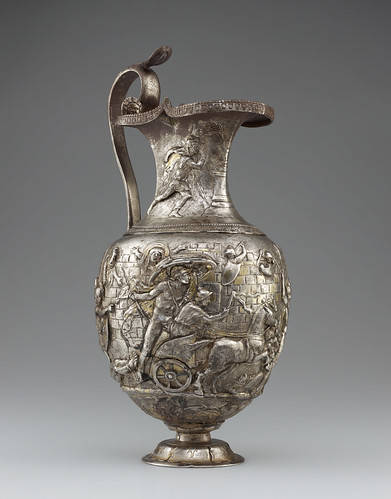
Roman, Pitcher with Scene from the Trojan War (one of a pair), “Achilles Dragging Hector before the Walls of Troy,” 1–100 AD, silver and gold, Bibliothèque nationale de France, département des monnaies, médailles et antiques, Paris. © The J. Paul Getty Museum
Precious gemstones, glass, jewelry, and other Roman luxury objects are on display alongside the featured Roman silver collection. This exhibition is the culmination of a comprehensive four-year project by the J. Paul Getty Museum in Los Angeles to conserve this historic and exquisite collection.

Signed by Pamphilos, Gem with Achilles Playing the Cithara, 75–50 BC, amethyst intaglio, Bibliothèque nationale de France, département des monnaies, médailles et antiques, Paris. © The J. Paul Getty Museum
Additionally, the Getty Museum converted its painstaking efforts to clean and restore the collection into a 4-minute video illustrating ancient techniques used by Roman silversmiths. A catalogue published by the Getty Museum accompanies the exhibition.
“We’re particularly grateful to the Getty Museum for their expertise and dedication in restoring the Berthouville Treasure, paving the way for additional research and study of these important antiquities,” said Gary Tinterow, director of the MFAH since 2012.
“The Museum of Fine Arts, Houston is honored to be the final U.S. stop for these significant treasures before they return to France next spring,” added Tinterow, who spearheaded blockbusters exhibitions at the Metropolitan Museum of Art in New York during his nearly 30-year tenure.
The J. Paul Getty Museum organized the exhibition in collaboration with the Bibliotheque Nationale de France, Department des Monnaies, Medailles et Antiques, Paris.
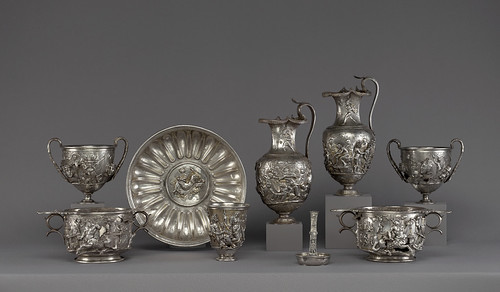
Roman, The Dedications of Quintus Domitius Tutus, silver and gold, Bibliothèque nationale de France, département des monnaies, médailles et antiques, Paris. © The J. Paul Getty Museum
The MFAH was founded in 1900 and is among the 10 largest art museums in the United States. The sprawling campus at 1001 Bissonnet includes several buildings which house two libraries, a repertory cinema, public archives, and more. Go to: www.mfah.org for ticket prices and hours of operation. Anyone interested in visiting may also call (713) 639-7300.
Want to learn more? Here’s an interesting lecture on The Berthouville Silver and Its Context:
Rosie Carbo is the Lifestyles Editor for Wandering Educators, and is a former newspaper reporter whose work has appeared in newspapers and magazines nationwide. Some of those publications include People magazine, The Dallas Morning News, The Houston Chronicle and San Antonio Express-News. Some of her features were redistributed by The Associated Press early in her career as an award-winning Texas journalist.
